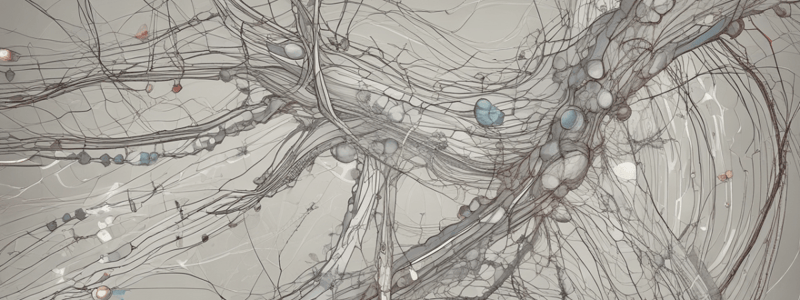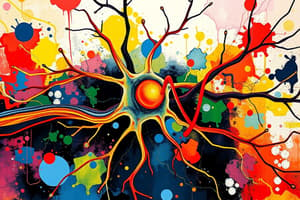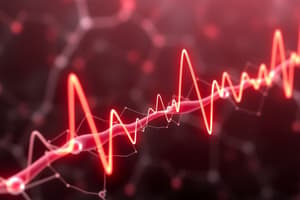Podcast
Questions and Answers
In the CNS, most neuronal ______ occurs in the gray matter
In the CNS, most neuronal ______ occurs in the gray matter
cell body
Axons are concentrated in the ______ matter
Axons are concentrated in the ______ matter
white
Cell bodies in the PNS are found in ______
Cell bodies in the PNS are found in ______
ganglia
Axons in the PNS are bundled in ______
Axons in the PNS are bundled in ______
Parkinson disease is caused by loss of dopamine-producing neurons in the CNS substantia ______
Parkinson disease is caused by loss of dopamine-producing neurons in the CNS substantia ______
Parkinson disease is treated with l-dopa, a precursor of ______
Parkinson disease is treated with l-dopa, a precursor of ______
The neuronal cell body contains the ______ and surrounding cytoplasm
The neuronal cell body contains the ______ and surrounding cytoplasm
The cell body acts as a trophic center, producing most ______ for the processes
The cell body acts as a trophic center, producing most ______ for the processes
This propagation, called the action potential, the depolarization wave, or the ______, is capable of traveling long distances along neuronal processes
This propagation, called the action potential, the depolarization wave, or the ______, is capable of traveling long distances along neuronal processes
By collecting, analyzing, and integrating information in such signals, the nervous system continuously stabilizes the intrinsic conditions of the body within normal ranges and maintains behavioral patterns
By collecting, analyzing, and integrating information in such signals, the nervous system continuously stabilizes the intrinsic conditions of the body within normal ranges and maintains behavioral patterns
The functional unit in both the CNS and PNS is the ______
The functional unit in both the CNS and PNS is the ______
Some neuronal components have special names, such as “neurolemma” for the ______
Some neuronal components have special names, such as “neurolemma” for the ______
Most neurons have three main parts: 1.The ______, which contains the nucleus and most of the cell’s organelles and serves as the synthetic or trophic center for the entire neuron
Most neurons have three main parts: 1.The ______, which contains the nucleus and most of the cell’s organelles and serves as the synthetic or trophic center for the entire neuron
Cell bodies can be very large, measuring up to 150 µm in diameter. Other neurons, such as those in the cerebellar granular layer, are among the body’s smallest ______
Cell bodies can be very large, measuring up to 150 µm in diameter. Other neurons, such as those in the cerebellar granular layer, are among the body’s smallest ______
The dendrites, which are the numerous elongated processes extending from the perikaryon and specialized to receive stimuli from other neurons at unique sites called ______
The dendrites, which are the numerous elongated processes extending from the perikaryon and specialized to receive stimuli from other neurons at unique sites called ______
The ______ are the numerous elongated processes extending from the perikaryon and specialized to receive stimuli from other neurons at unique sites called synapses
The ______ are the numerous elongated processes extending from the perikaryon and specialized to receive stimuli from other neurons at unique sites called synapses
Proximal regions of the astrocytic processes are reinforced with bundles of intermediate filaments made of glial fibrillary acid protein (GFAP), which serves as a unique marker for this ______ cell.
Proximal regions of the astrocytic processes are reinforced with bundles of intermediate filaments made of glial fibrillary acid protein (GFAP), which serves as a unique marker for this ______ cell.
Distally the processes lack GFAP, are not readily seen by microscopy, and form a vast network of delicate terminals contacting ______ and other structures.
Distally the processes lack GFAP, are not readily seen by microscopy, and form a vast network of delicate terminals contacting ______ and other structures.
Terminal processes of a single astrocyte typically occupy a large volume and associate with over a million ______ sites.
Terminal processes of a single astrocyte typically occupy a large volume and associate with over a million ______ sites.
Astrocytes originate from progenitor cells in the embryonic neural tube and are by far the most numerous ______ cells of the brain, as well as the most diverse, structurally and functionally.
Astrocytes originate from progenitor cells in the embryonic neural tube and are by far the most numerous ______ cells of the brain, as well as the most diverse, structurally and functionally.
There are two main morphological types of astrocytes: protoplasmic and ______ astrocytes.
There are two main morphological types of astrocytes: protoplasmic and ______ astrocytes.
Protoplasmic astrocytes have a ______ appearance due to their many radiating processes and are primarily found in the grey matter.
Protoplasmic astrocytes have a ______ appearance due to their many radiating processes and are primarily found in the grey matter.
Functions attributed to astrocyte: Buffering extracellular K+ levels Regulating the extracellular ionic concentrations around ______.
Functions attributed to astrocyte: Buffering extracellular K+ levels Regulating the extracellular ionic concentrations around ______.
Fibrous astrocytes have relatively few but longer cytoplasmic processes that align with the nerve axons and are mainly found in ______ matter.
Fibrous astrocytes have relatively few but longer cytoplasmic processes that align with the nerve axons and are mainly found in ______ matter.
The spinal cord shows bilateral symmetry around the CSF-filled central ______
The spinal cord shows bilateral symmetry around the CSF-filled central ______
In the spinal cord, the gray matter forms a roughly H-shaped structure with two posterior (sensory) horns and two anterior (motor) ______
In the spinal cord, the gray matter forms a roughly H-shaped structure with two posterior (sensory) horns and two anterior (motor) ______
The gray matter in the spinal cord contains abundant astrocytes and large neuronal cell bodies, especially those of motor neurons in the ventral ______
The gray matter in the spinal cord contains abundant astrocytes and large neuronal cell bodies, especially those of motor neurons in the ventral ______
The white matter in the spinal cord contains primarily oligodendrocytes and tracts of myelinated axons running along the length of the ______
The white matter in the spinal cord contains primarily oligodendrocytes and tracts of myelinated axons running along the length of the ______
With H&E staining, the large motor neurons of the ventral horns show large nuclei, prominent nucleoli, and cytoplasm rich in Nissl substance, all indicating extensive protein synthesis to maintain the axons of these cells that extend great ______
With H&E staining, the large motor neurons of the ventral horns show large nuclei, prominent nucleoli, and cytoplasm rich in Nissl substance, all indicating extensive protein synthesis to maintain the axons of these cells that extend great ______
In the white commissure ventral to the central canal, tracts run lengthwise along the cord, seen here in cross section with empty myelin sheaths surrounding axons, as well as small tracts running from one side of the cord to the ______
In the white commissure ventral to the central canal, tracts run lengthwise along the cord, seen here in cross section with empty myelin sheaths surrounding axons, as well as small tracts running from one side of the cord to the ______
The skull and the vertebral column protect the CNS, but between the bone and nervous tissue are membranes of connective tissue called the ______
The skull and the vertebral column protect the CNS, but between the bone and nervous tissue are membranes of connective tissue called the ______
Three meningeal layers are distinguished: the dura, arachnoid, and pia ______
Three meningeal layers are distinguished: the dura, arachnoid, and pia ______
The middle meningeal layer is the thicker weblike ______ mater (A) containing the large subarachnoid space (SA)
The middle meningeal layer is the thicker weblike ______ mater (A) containing the large subarachnoid space (SA)
The subarachnoid space is filled with ______ and the arachnoid acts as a shock-absorbing pad between the CNS and bone
The subarachnoid space is filled with ______ and the arachnoid acts as a shock-absorbing pad between the CNS and bone
Fairly large blood vessels (BV) course through the ______
Fairly large blood vessels (BV) course through the ______
The innermost pia mater (P) is thin and is not clearly separate from the ______; together, they are sometimes referred to as the pia-arachnoid or the leptomeninges
The innermost pia mater (P) is thin and is not clearly separate from the ______; together, they are sometimes referred to as the pia-arachnoid or the leptomeninges
The space between the pia and the white matter (WM) of the spinal cord here is an artifact created during dissection; normally the pia is very closely applied to a layer of astrocytic processes at the surface of the CNS tissue
The space between the pia and the white matter (WM) of the spinal cord here is an artifact created during dissection; normally the pia is very closely applied to a layer of astrocytic processes at the surface of the CNS tissue
The blood-brain barrier (BBB) is a functional barrier that allows much tighter control than that in most tissues over the passage of substances moving from blood into the CNS tissue. The main structural component of the BBB is the capillary ______
The blood-brain barrier (BBB) is a functional barrier that allows much tighter control than that in most tissues over the passage of substances moving from blood into the CNS tissue. The main structural component of the BBB is the capillary ______
The limiting layer of perivascular ______ feet, which closely envelops the basement membrane of the continuous capillaries in most CNS region, also contributes to the BBB and further regulates passage of molecules and ions from blood to brain
The limiting layer of perivascular ______ feet, which closely envelops the basement membrane of the continuous capillaries in most CNS region, also contributes to the BBB and further regulates passage of molecules and ions from blood to brain
The cell body acts as a trophic center, producing most ______ for the processes
The cell body acts as a trophic center, producing most ______ for the processes
Study Notes
Nervous System
- The nervous system continuously stabilizes the body's intrinsic conditions, such as blood pressure, oxygen and carbon dioxide content, pH, blood glucose levels, and hormone levels, within normal ranges.
- It maintains behavioral patterns, like feeding, reproduction, defense, and interaction with other living creatures, by collecting, analyzing, and integrating information from signals.
Neurons
- The functional unit in both the Central Nervous System (CNS) and Peripheral Nervous System (PNS) is the neuron.
- Neurons have three main parts: the cell body (perikaryon or soma), dendrites, and the axon.
- The cell body contains the nucleus and most of the cell's organelles, serving as the synthetic or trophic center for the entire neuron.
- Dendrites are numerous elongated processes extending from the perikaryon, specialized to receive stimuli from other neurons at unique sites called synapses.
- The axon is a single long process ending at synapses, specialized to generate and conduct nerve impulses to other cells.
Blood-Brain Barrier
- The Blood-Brain Barrier (BBB) is a functional barrier that allows tighter control over the passage of substances moving from blood into the CNS tissue.
- The main structural component of the BBB is the capillary endothelium, which has tightly sealed cells, little or no transcytosis activity, and is surrounded by the basement membrane.
- The limiting layer of perivascular astrocytic feet also contributes to the BBB, regulating passage of molecules and ions from blood to brain.
Cell Body (Perikaryon or Soma)
- The neuronal cell body contains the nucleus and surrounding cytoplasm, exclusive of the cell processes.
- It acts as a trophic center, producing most cytoplasm for the processes.
- Most cell bodies are in contact with a great number of nerve endings conveying excitatory or inhibitory stimuli generated in other neurons.
Astrocytes
- Astrocytes originate from progenitor cells in the embryonic neural tube and are the most numerous glial cells of the brain.
- There are two main morphological types of astrocytes: protoplasmic and fibrous astrocytes.
- Protoplasmic astrocytes have a starlike appearance and are primarily found in the grey matter.
- Fibrous astrocytes have relatively few but longer cytoplasmic processes that align with the nerve axons and are mainly found in white matter.
- Functions attributed to astrocytes include buffering extracellular K+ levels and regulating the extracellular ionic concentrations around neurons.
Parkinson Disease
- Parkinson disease is a slowly progressing disorder affecting muscular activity, characterized by tremors, reduced activity of the facial muscles, loss of balance, and postural stiffness.
- It is caused by the gradual loss of dopamine-producing neurons whose cell bodies lie within the nuclei of the CNS substantia nigra.
- Parkinson disease is treated with l-dopa, a precursor of dopamine that augments the declining production of this neurotransmitter.
Spinal Cord
- The spinal cord varies slightly in diameter along its length but in cross section always shows bilateral symmetry around the small, CSF-filled central canal.
- The gray matter is internal, forming a roughly H-shaped structure that consists of two posterior (sensory) and two anterior (motor) horns, all joined by the gray commissure around the central canal.
- The white matter surrounds the gray matter and contains primarily oligodendrocytes and tracts of myelinated axon running along the length of the cord.
Meninges
- The skull and the vertebral column protect the CNS, but between the bone and nervous tissue are membranes of connective tissue called the meninges.
- Three meningeal layers are distinguished: the dura, arachnoid, and pia maters.
- The subarachnoid space is filled with CSF and the arachnoid acts as a shock-absorbing pad between the CNS and bone.
Studying That Suits You
Use AI to generate personalized quizzes and flashcards to suit your learning preferences.
Related Documents
Description
Learn about the propagation of nerve impulses known as action potential and its role in transmitting signals along neuronal processes. Explore how the nervous system regulates and stabilizes the body's internal conditions.



